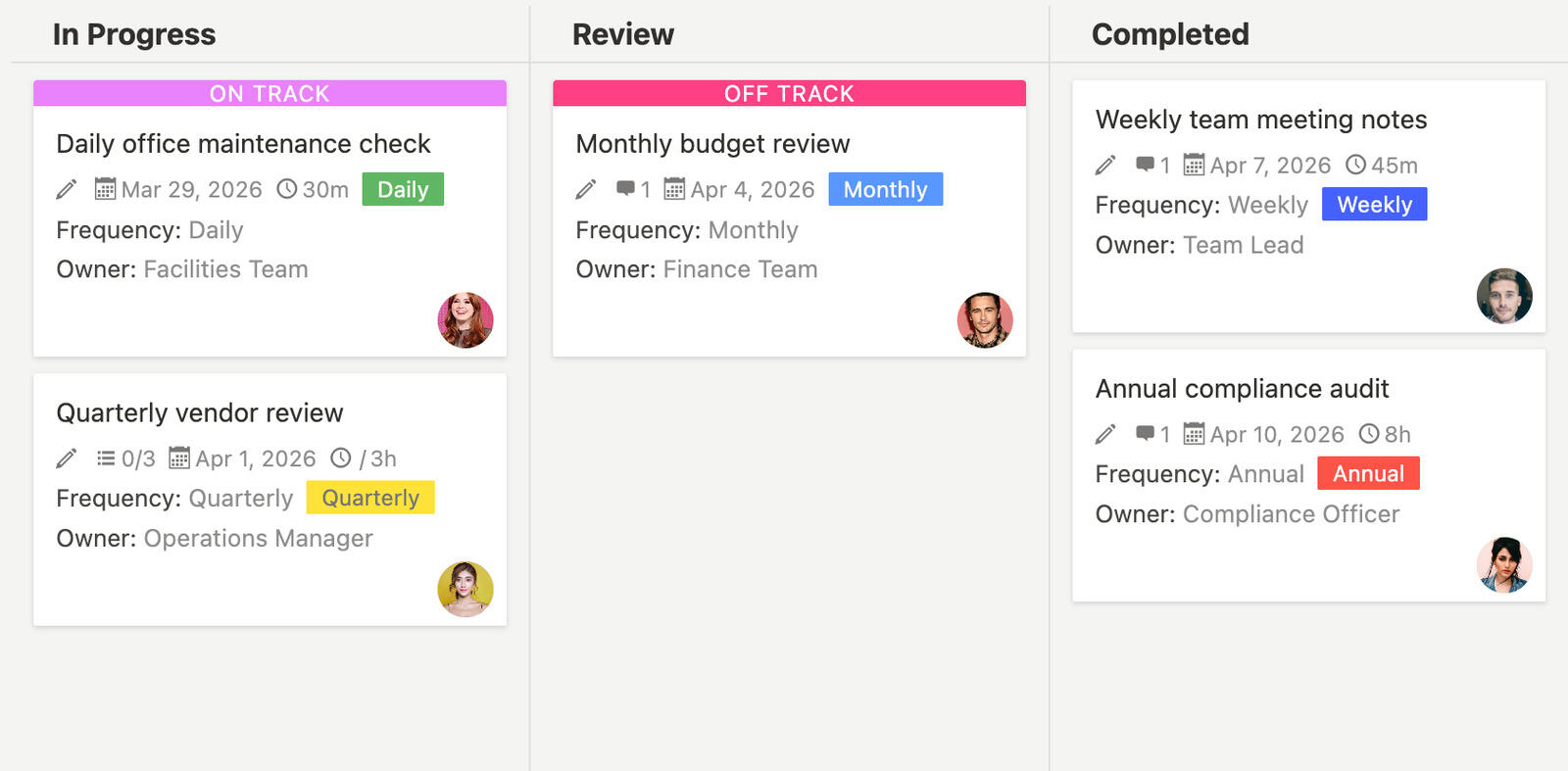
- Templates |
- Operations |
- Recurring office tasks without spreadsheets
Recurring office tasks template
Manage recurring office tasks without spreadsheets. A recurring office tasks template helps you automate recurring work so tasks generate on schedule and eliminate manual spreadsheet updates.

Managing recurring office tasks means handling everything from weekly inventory checks and monthly expense reports to daily maintenance and quarterly reviews. Without a clear system, recurring tasks get forgotten, deadlines are missed, and operations become inconsistent. A recurring office tasks template gives you a structure to automate recurring work so tasks generate on schedule and eliminate the need for manual spreadsheet updates.
What is a recurring office tasks template?
A recurring office tasks template is a tool that helps you organize and manage recurring work that happens on a regular schedule. It gives you a structure to create recurring card templates that generate automatically on schedule with deadlines, assignees, and checklists. The template helps you automate recurring work so the schedule maintains itself without manual updates.
Using a template means you don't have to remember to create tasks each week, month, or day. It automates the schedule so recurring tasks appear automatically with the same structure, deadline, and assignee every time.
Why do you need a recurring office tasks template?
Managing recurring tasks with spreadsheets means someone has to remember to add new rows, duplicate templates, and check the sheet daily. This manual effort leads to forgotten tasks, missed deadlines, and inconsistent operations. A recurring office tasks template helps you maintain consistency automatically. Here's what it does:
- Automated task creation generates tasks automatically on schedule without manual entry
- Schedule maintenance keeps the schedule current because tasks generate automatically
- Deadline visibility shows all upcoming tasks with deadlines visible to team members
- Consistency ensures recurring work happens on schedule every time
- Reminder automation notifies people when deadlines approach
- Progress tracking shows which recurring tasks are completed and which are overdue
- Template customization lets you customize recurring tasks with checklists and attachments
- Assignment automation assigns recurring tasks to the right people automatically
- Time savings eliminates 4-5 hours per week spent on manual spreadsheet updates
- Error reduction prevents forgotten tasks and missed deadlines
Without a template, recurring tasks depend on manual spreadsheet updates that get forgotten or delayed, leading to inconsistent operations.
A static template is a good starting point, but using a project management tool like Breeze makes recurring task management much more effective. With Breeze, you can create recurring card templates that generate automatically on schedule, set reminders for when tasks are due, customize recurring tasks with checklists and attachments, assign recurring tasks to specific people or rotate assignments, and see all upcoming tasks automatically without manual entry. Instead of managing recurring tasks through spreadsheets, you get an automated system that maintains itself.
What goes into a recurring office tasks template?
A recurring office tasks template should include sections for organizing all the different types of recurring work. Here's what typically goes into it:
- Task categories like weekly tasks, monthly tasks, daily checks, quarterly reviews, or annual audits
- Recurrence schedule - weekly, monthly, daily, quarterly, or custom intervals
- Task templates with structure, checklist, and instructions that match the recurring work
- Deadline settings for when recurring tasks should be completed
- Assignment rules to show who handles each recurring task
- Checklists that match the steps for that recurring work
- Attachments like templates or files that team members need
- Reminder settings to notify people when deadlines approach
- Progress tracking to see which recurring tasks are completed on time
- Custom fields for data that's specific to your recurring work
Customize the template to match your operations needs. Add recurring tasks for the work that happens regularly, adjust schedules based on your needs, and include checklists and attachments that help your team work more efficiently.
Frequently asked questions about recurring office tasks templates
What types of recurring tasks should I track in the template?
You should track all types of recurring office tasks in the template, including weekly inventory checks, monthly expense reports, daily office maintenance, quarterly vendor reviews, annual compliance audits, and any other recurring work that happens on a regular schedule. The template helps you automate these different types so they generate automatically and you don't have to remember to create them.
How do you set up recurring tasks for common office work?
Create templates for weekly reports, monthly reviews, and daily checks. Identify the recurring patterns in your operations - what happens weekly, monthly, or daily. Create a card template for each pattern with the structure, deadline, and assignee. Set each template to recur on its schedule. The board shows all upcoming tasks automatically, so operations stay consistent.
How do you keep recurring tasks from getting forgotten?
Use reminders, visual tracking, and clear due dates. When tasks generate automatically, they appear in the board with deadlines. Reminders notify people when deadlines approach. Visual tracking shows which tasks are due soon. The board maintains visibility, so team members see what needs attention and managers see what's at risk.
How do you customize recurring tasks for different needs?
Use templates, checklists, and assignees that match your specific office needs. Each recurring task can have its own template with the structure, checklist, and instructions that match that work. Each can have its own assignee or assignment rules, and its own schedule and deadline. Templates make customization easy - create a card template for each type of recurring work with the structure that matches that work.
Can you skip a recurring task for a specific week or month?
Yes. When a recurring task generates, you can delete or archive that specific card without affecting the recurring template. The template continues to generate future cards on schedule. You can also pause the recurring template temporarily if you need to skip multiple occurrences.




